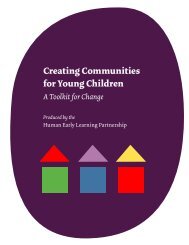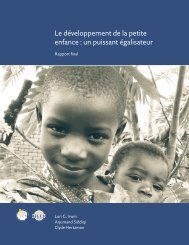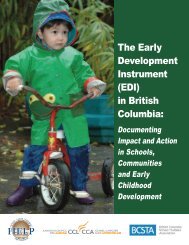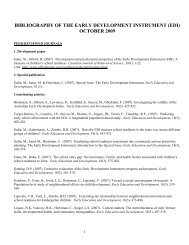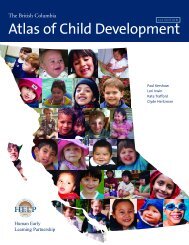Total Environment Assessment Model for Early Child Development
Total Environment Assessment Model for Early Child Development
Total Environment Assessment Model for Early Child Development
Create successful ePaper yourself
Turn your PDF publications into a flip-book with our unique Google optimized e-Paper software.
<strong>Total</strong> <strong>Environment</strong> <strong>Assessment</strong> <strong>Model</strong><br />
<strong>for</strong> <strong>Early</strong> <strong>Child</strong> <strong>Development</strong><br />
Executive Summary<br />
The early child period is considered to be<br />
the most important developmental phase<br />
throughout the lifespan. Healthy early<br />
child development [ecd]—which includes<br />
the physical, social—emotional, and language—cognitive<br />
domains of development,<br />
each equally important—strongly influences<br />
well-being, obesity/stunting, mental<br />
health, heart disease, competence in literacy<br />
and numeracy, criminality, and economic<br />
participation throughout life. What happens<br />
to the child in the early years is critical <strong>for</strong><br />
the child’s developmental trajectory and<br />
lifecourse.<br />
The principal strategic insight of this<br />
document is that the nurturant qualities of<br />
the environments where children grow up,<br />
live, and learn matter the most <strong>for</strong> their development,<br />
yet parents cannot provide strong<br />
nurturant environments without help from<br />
local, regional, national, and international<br />
agencies. There<strong>for</strong>e, this report’s principal<br />
contribution is to propose ways in which government<br />
and civil society actors, from local<br />
to international, can work in concert with<br />
families to provide equitable access to strong<br />
nurturant environments <strong>for</strong> all children globally.<br />
Recognizing the strong impact of ecd on<br />
adult life, it is imperative that governments<br />
recognize that disparities in the nuturant<br />
environments required <strong>for</strong> healthy child<br />
development, will impact differentially on<br />
the outcome of different nations and societies.<br />
In some societies, inequities in ecd translate<br />
into vastly different life chances <strong>for</strong> children;<br />
in others, however, disparities in ecd reach a<br />
critical point, where they become a threat to<br />
peace and sustainable development.<br />
The early years are marked by the<br />
most rapid development, especially of the<br />
central nervous system. The environmental<br />
conditions to which children are exposed,<br />
including the quality of relationships and<br />
language environment,[in the earliest years]<br />
literally “sculpt” the developing brain.<br />
The environments that are responsible <strong>for</strong><br />
fostering nurturant conditions <strong>for</strong> children<br />
range from the intimate realm of the family<br />
to the broader socioeconomic context shaped<br />
by governments, international agencies, and<br />
civil society. These environments and their<br />
characteristics are the determinants of ecd;<br />
in turn, ecd is a determinant of health, wellbeing,<br />
and learning skills across the balance of<br />
the lifecourse.<br />
The seeds of adult gender inequity are<br />
sewn in early childhood. In the early years,<br />
gender equity issues—in particular, gender<br />
socialization, feeding practices, and access to<br />
schooling—are determinants of ecd. <strong>Early</strong><br />
gender inequity, when rein<strong>for</strong>ced by power<br />
relations, biased norms, and day-to-day<br />
experiences in the family, school, community,<br />
and broader society, go on to have a<br />
profound impact on adult gender inequity.<br />
Gender equity from early childhood onwards<br />
influences human agency and empowerment<br />
in adulthood.<br />
Economists now assert on the basis of the<br />
available evidence that investment in early<br />
childhood is the most powerful investment<br />
a country can make, with returns over the<br />
lifecourse many times the size of the original<br />
investment.<br />
The scope of the present report is fourfold:<br />
1. To demonstrate which environments matter<br />
most <strong>for</strong> children. This includes environments<br />
from the most intimate (family) to the most<br />
remote (global).<br />
2 . To review which environmental configurations<br />
are optimal <strong>for</strong> ecd, including aspects of<br />
environments that are economic, social, and<br />
physical in nature.<br />
3. To determine the “contingency relationships”<br />
that connect the broader socioeconomic<br />
context of society to the quality of nurturing<br />
in intimate environments such as families and<br />
communities.<br />
4 . To highlight opportunities to foster nurturant<br />
conditions <strong>for</strong> children at multiple levels of<br />
society (from family-level action to national<br />
and global governmental action) and by<br />
multiple means (i.e. through programmatic<br />
implementation, to “child-centered” social and<br />
economic policy development).<br />
In keeping with international policy<br />
standards, early childhood is defined as the<br />
Executive<br />
Summary



